Fashion designer and business owner Kim Woo-Jung makes simple, comfortable clothes using natural fabrics. Five years ago, after trying out many different parts of Seoul, she finally settled down in Seochon. Her designs are often praised for reflecting the spirit of the quaint neighborhood.
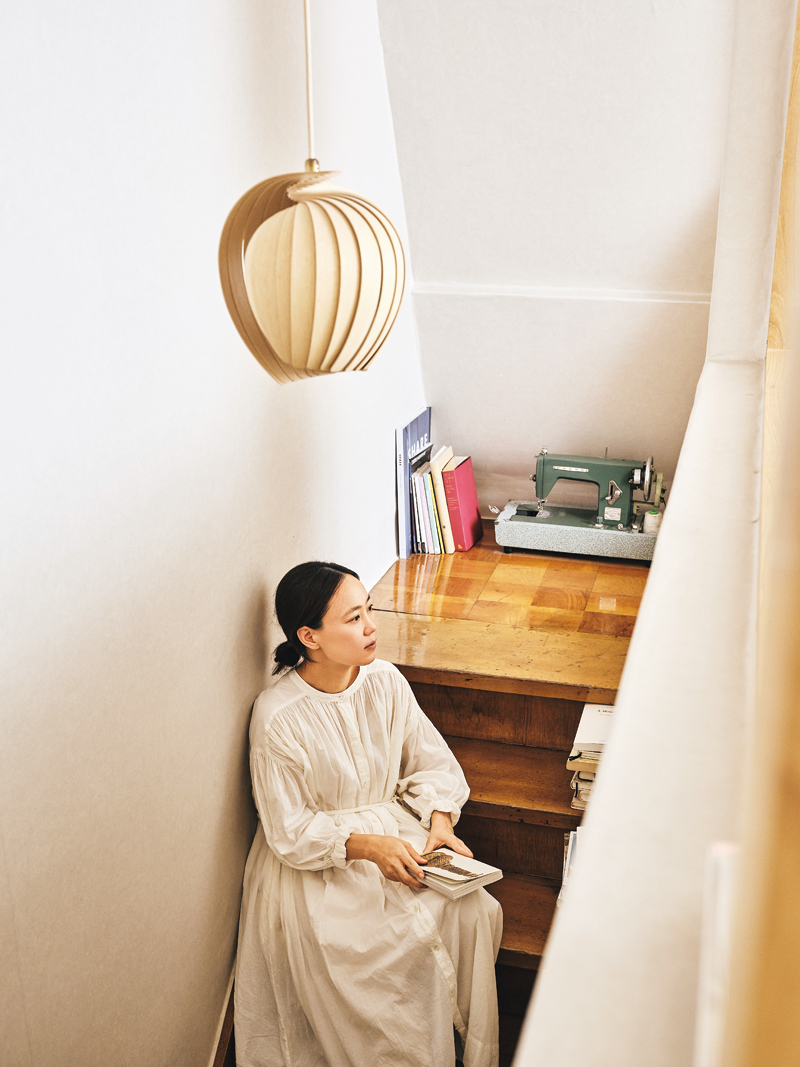
Fashion designer Kim Woo-Jung, who has lived in many neighborhoods throughout Seoul, set up her studio in Seochon five years ago and quickly grew attached to the neighborhood. Last year, she relocated to a house with a stunning view of Mt. Inwang and is now thoroughly enjoying the Seochon lifestyle.
The Korean verb jitda may be used when speaking about cooking rice, making clothes, or building a home, reflecting basic daily needs for food, clothing, and shelter. “May this meal bring you good health, may these clothes bring you comfort, and may this home bring you joy” — these heartfelt wishes are the underlying sentiment. They are also the spirit sewn into the clothing brand Gajungsic Fabric, founded by Kim Woo-Jung in 2015.
The company’s name is an alternative spelling of gajeongsik, which refers to home-cooked food and is often found on restaurant signs to indicate the type of meals customers can expect. Like the comforting feeling of a mother’s cooking, Kim strives to imbue her line of clothing with a homey and heartfelt touch.
“Home-cooked food makes you feel good, doesn’t it? Like meals made with wholesome ingredients and fewer artificial additives, I use natural, durable materials to make beautiful garments that never go out of style,” she says.
“After years of studying and working in the clothing industry, experimenting with everything from synthetic fibers to all sorts of other materials, I came to the conclusion that nothing surpasses natural fabrics in terms of quality.”
HIGH QUALITY MATERIALS
Kim’s love for clothing began in her childhood years, growing up in Masan, a port city at the southeastern tip of Korea. She studied fashion design at a university in Seoul, and then spent a decade working as a designer for a children’s and women’s wear company. Her focus then was on trends and efficiency, producing clothes that could be made and sold as quickly as they were forgotten. The hectic pace sapped Kim’s energy and spirit, but sewing her own clothes provided an escape. Finally, after taking a three-month trip to recharge and reflect, Kim realized that she had lost touch with herself. So, she quit and began to focus on what truly made her happy.
For Kim, the main reward for owning her own business is not monetary but having a platform allowing her to do what she loves. That’s why she approaches each piece of clothing she makes as if it were a work of art. After leaving the fast-fashion world, she now enjoys the luxury of dictating the rhythm of her work.
“In today’s fast-paced world, where too much of everything is made — and too quickly — I wanted to take a slower, more mindful approach to making clothes. At the clothing company where I used to work, the focus was always on sales targets, inventory management, and keeping production costs low to maximize profits. But I wanted to take my time to create clothes that would resonate with people on a deeper level, even if that meant having fewer customers. I believe that when people choose clothes made with care, it directly affects their mood when they wear them.”
Kim refuses to cut corners on materials to maximize earnings. To her, fabric is as important to clothing as ingredients are to food. She is especially fond of linen and cotton. She recommends linen for spring and summer clothing and spends more than half the year wearing linen dresses herself. “What I love about linen is how it molds to the body over time and gives a natural, relaxed look,” she says.
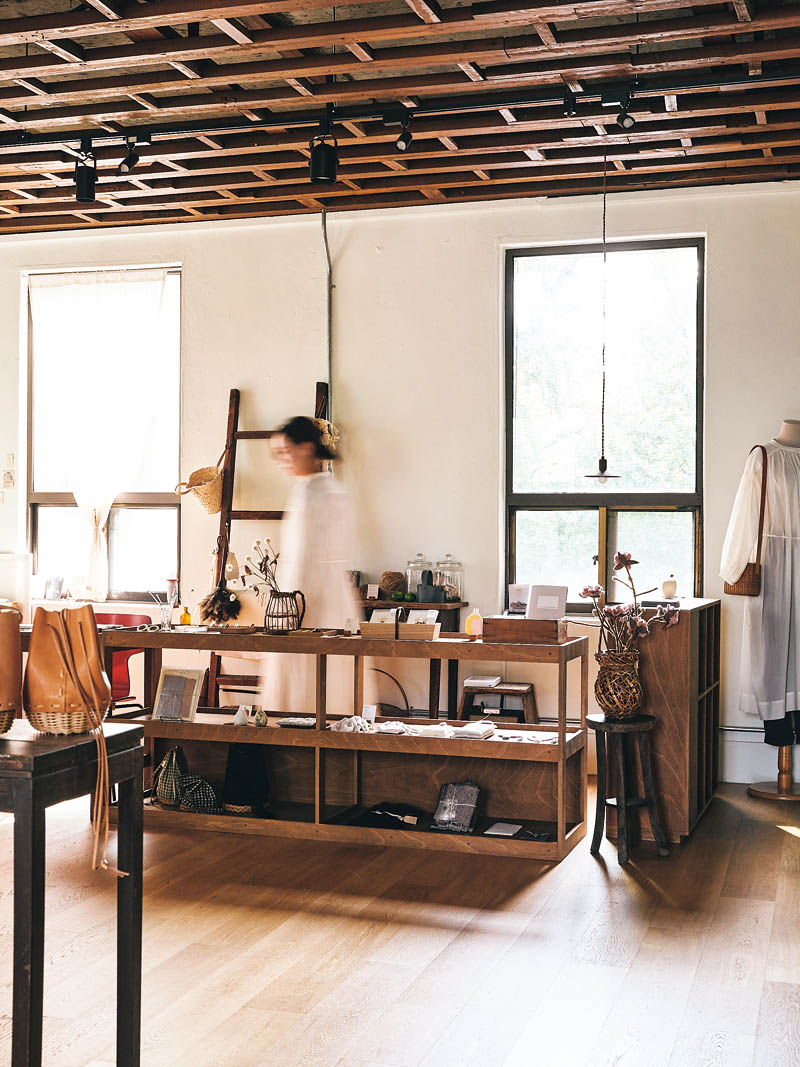
The Gajungsic Fabric showroom in Jeong-dong, central Seoul. Kim believes that clothing should warm the soul as much as the body, and hopes her meticulously crafted clothes can provide lasting comfort to those who wear them.
Although her earnings aren’t enormous, Kim travels around the world to source the best materials for her clothes. She gets her wool primarily from England, which has a long history of wool production, and her linen from Belgium and Lithuania, two countries famous for quality textiles. To secure quality cashmere at a good price, she buys directly from goat farms in Mongolia. Other places she frequently visits are Italy for its expertly crafted textiles, Japan for fabric with a homemade feel woven on vintage power looms, and India for organic cotton and khadi, which are both beautiful and sustainable.
Since obtaining the best materials is no easy task, her production volume is inevitably limited. “Good materials and simple, classic designs are what make clothes that last,” Kim says confidently. She finds fulfillment in her philosophy of “producing just enough to ensure everything sells out and nothing goes to waste.”
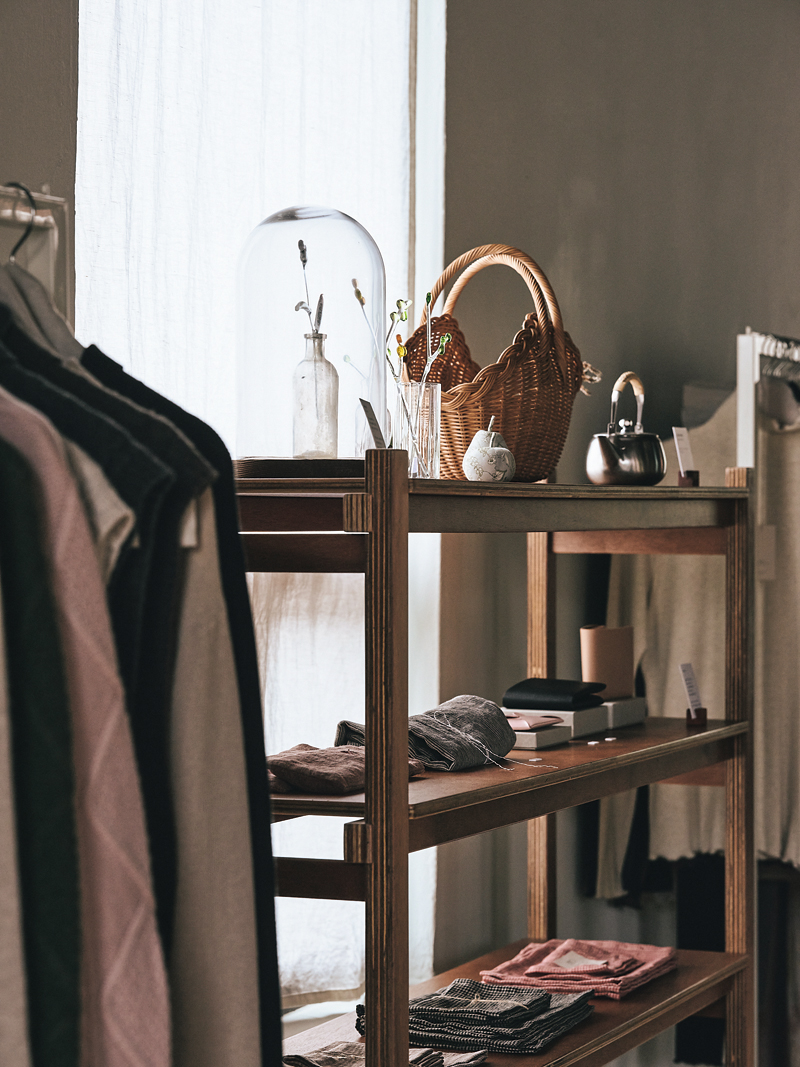
The showroom shelves display a selection of handcrafted works, many of which are made by artists based in Seochon. Kim enjoys collaborating with local artists who work with different materials such as glass, ceramics, metal, and leather, and regularly hosts exhibitions of their creations.
SEOCHON LIVING
Kim’s customers are mostly regulars, quiet individuals who prefer to maintain a low profile. Some are the daughters of long-time customers who have been handed down clothes from their mothers.
“It’s truly rewarding to know that our clothes appeal to different generations because it means they never go out of style,” Kim says. While many customers shop online through her long-running blog or the brand’s website, an increasing number of them want to see and feel the clothes for themselves, which has led Kim to open a showroom in Jeong-dong, a neighborhood in downtown Seoul. It’s a cozy boutique inside the Annex Building of the Former Shin-A Ilbo, a four-story, red brick structure from the 1930s that originally housed the Korean branch of Singer, the American sewing machine company. It later served as the headquarters of the Shin-A Ilbo, Korea’s first commercial newspaper, and is now a Registered Cultural Heritage of Korea.
Gajungsic’s clothes, which are becoming increasingly popular through word of mouth, are often described as having a distinct Seochon vibe. But what does that mean?
“It’s natural clothing,” Kim explains. “Clothes that are simple enough for a stroll through the neighborhood, but also refined enough for a visit to a museum. They’re not flashy, but not sloppy either. Clothes are the closest things to our bodies, wrapping around us every day, so I want them to feel soothing. When people say our clothes have a Seochon vibe, I think they mean that they strike a balance between comfort and neatness, while also having a cozy warmth to them.”
Kim settled in Seochon five years ago after falling in love with the neighborhood. This came after years of living in many different parts of the city, her current address being her eighteenth in Seoul and the third since getting married. Kim and her husband, Jeong Yeongmin, now occupy the third and fourth floors of a mixed-use building. She decided to move here as soon as she entered the sunlit space and saw the stunning view of Mt. Inwang through the living room window.
“Seochon blends the old with the new. A short walk away, you’ll find towering skyscrapers, but if you go deeper into the neighborhood, you’ll discover charming alleys like the ones I used to play in as a child. These alleys are a mix of hanok and modern homes. Seochon is a neighborhood where you might just as easily stumble upon a grandmother drying chili peppers in the sun by the roadside as you’ll see young people strolling by dressed in the latest fashion. That’s what makes it so special. Seochon has an authentic, lived-in feel that more commercialized areas like Myeongdong or Gangnam are lacking.”
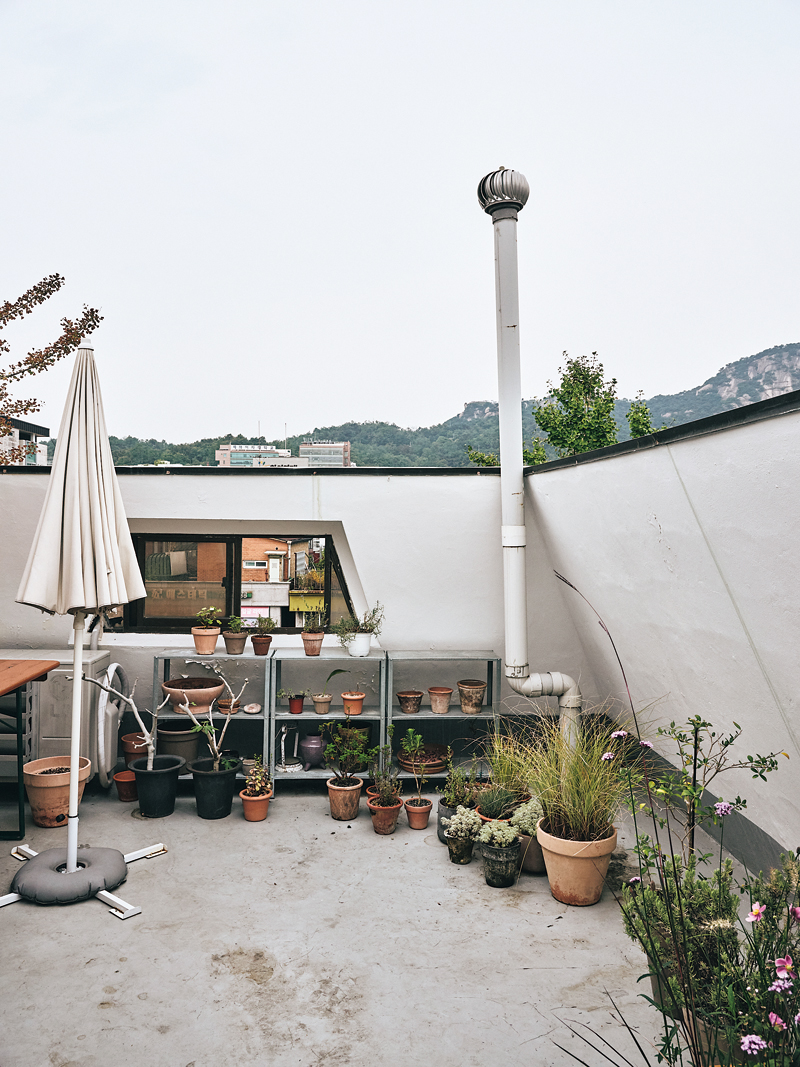
On the rooftop, with a view of Mt. Inwang, are a collection of plants carefully tended by Jeong Yeongmin, Kim’s husband, who is fond of gardening. In the evening, Kim comes here to enjoy the sunset over Seochon.
NEXT TO NATURE
Seochon is also a place where traces of time and scents of daily life come together, and where age and oldness are seen as virtues. The proximity to nature, with its calming and restorative effect, is another blessing.
“It’s a low-rise neighborhood free of tall buildings, which means Mt. Inwang is always visible in the distance. Even though Seochon is nestled within the old city walls, it is just a short walk to Suseong-dong Valley and an observation deck with sweeping views of Seoul. Here, only a stone’s throw away, one can take a step back from the city’s hustle and bustle. It’s the ideal place to relax and recharge. That’s why I love Seochon,” Kim says.
A magpie swooping into the ginkgo tree outside Kim’s living room window suddenly interrupts. “This spring, two magpies built a nest in that tree. They are always flying back and forth, gathering twigs. I often wonder where they find them all. They occasionally drop some, which has left the ground beneath the tree littered with twigs.”
Kim and her husband renovated and decorated their home much like birds building their nests. After leaving a successful career in advertising and marketing to start a new life, Jeong took charge of transforming their living space. He painted the walls, chose fresh colors for the doors and built-in closets, and replaced the lighting, doorknobs, and handles throughout the home, often incorporating items Kim had gathered during her travels to Europe.
The couple also laid down carpets and brought in furniture they handpicked from vintage shops. In their small rooftop garden, they planted anemones that bloom until the first frost, apple mint that gives off a pleasant scent when touched, tall fountain grasses, as well as silver mounds. It has been nearly a year since their move, and the slow, intentional process they used to tailor their home to their liking mirrors Kim’s approach to making clothes.
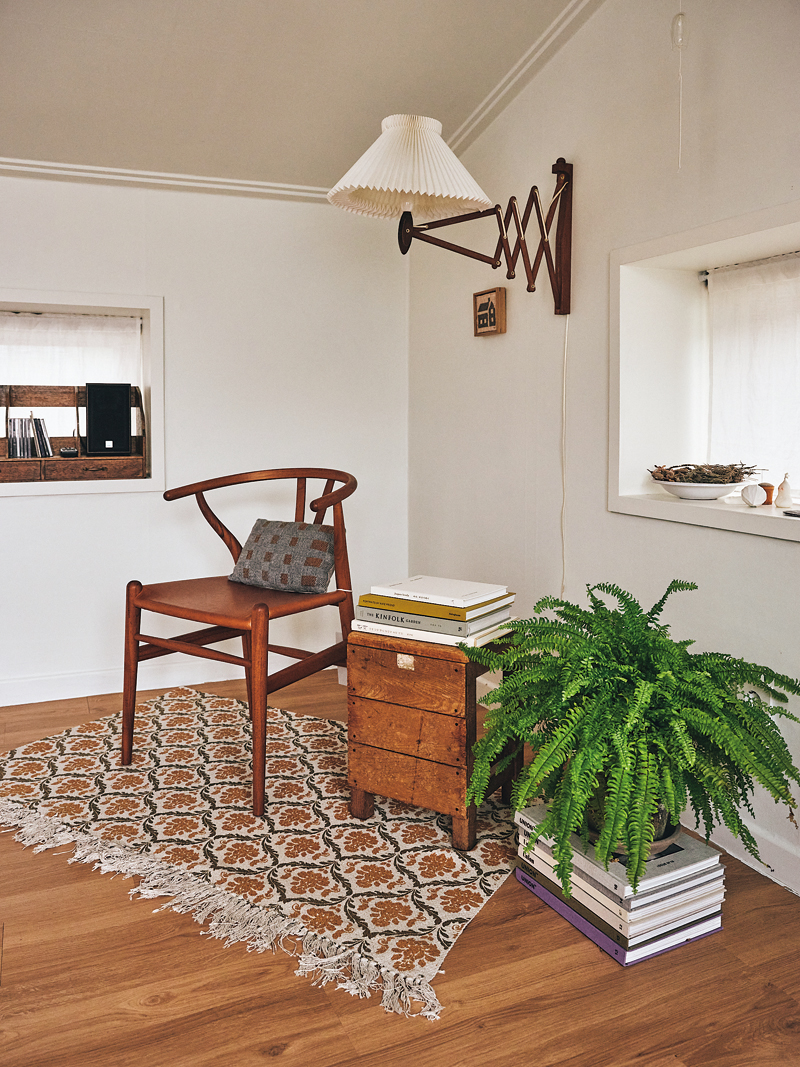
Kim and her husband adorned their home with vintage items they have collected over the years and frequently host get-togethers with their neighbors.
Kim adorned her living room with the works of local Seochon artists. In front of the window hangs a small painting by Sue Oh, titled Stones of Mount Inwang. A painting by Ko Jiyoung also hangs on the warm, butter-yellow wall, and under it a handmade doll by knitting artist Bosong Kang sits atop the storage cabinet. The four of them came to know each other through their shared interests.
“I recently found out that a glass artist I’ve admired for years lives in Seochon. This neighborhood is full of people pursuing their passions on their own terms. I sometimes display works by artists whose tastes are similar to mine in a corner of the showroom. I find they complement my clothing. My husband, who enjoys playing the ukulele and woodworking, has turned our fourth-floor attic into a space where we can hold book talks and small cultural gatherings. Just as some share meals with their neighbors, we share culture and experiences with ours.”
Kim does what she loves, has made friends with some wonderful people, and turns to nature for comfort when needed — all possible, she says, because she lives in Seochon.
Cho Sang In Art Journalist
Heo Dong-wuk Photographer